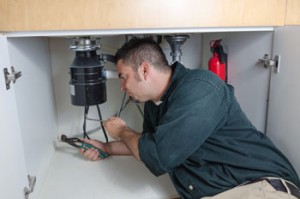Garbage disposals make kitchen cleanup easier. They grind the small pieces of food that inevitably fall in the sink and get washed down the drain. A broken or blocked disposal is an inconvenience, leading to messy leaks and smelly clogs
 Using the disposal regularly and following a few common-sense practices will keep this handy device running smoothly. Here’s what you need to know:
Using the disposal regularly and following a few common-sense practices will keep this handy device running smoothly. Here’s what you need to know:
- Use cold water with the disposal. When you use the unit, run cold water while it’s grinding. When the food passes through, let the tap run for a few more seconds. Cold water keeps fats from getting soft and sticking to the blades. How water promotes the accumulation of grease.
- Don’t overload the disposal. Fibrous foods such as corn husks, celery stalks, onion skins and artichokes can jam the motor and block pipes. Don’t put large amounts of food down the drain. Feed the disposal with small scraps, dropping them in a few at a time. Small pieces of garbage allow water to flow and keep the drain clear.
- Keep it clean. Discourage buildup with regular cleaning. Poor baking soda and vinegar down the drain to remove odors and keep blades clean. After washing dishes, run the disposal with a few drops of dish soap. To banish bad smells, place a slice or two of lemon down the disposal. Lemons clean the unit as they are ground, leaving a fresh citrus scent in the drain.
- Sharpen blades with ice. Grind ice cubes to keep the blades sharp. Clean and sharpen simultaneously by throwing a few ice cubes and one cup of rock salt down the drain. Ice discourages grease buildup by scrubbing the blades and other areas of the disposal. Clean with ice once or twice per month.
- Never insert fingers into the garbage disposal. Use long pliers to remove food stuck in the drain. You can also try spearing the food with a knitting needle or grabbing it with chopsticks. Disposals cause injuries even when they not on. Tension in the blades can suddenly release upon removal of jammed food. If this happens while your hand is in the disposal, you could get injured.
- Reset the disposal. If the unit won’t turn on, push the reset button to bring it back to life. Look under the sink and find a button, usually red, on the bottom of the motor. You can also check the fuse box or circuit breaker.
Sometimes, despite your best efforts, the disposal fails or the drain clogs. Contact us for prompt help with plumbing problems. We can replace your disposal, repair your drain and get your kitchen back in shipshape.
Recommended Posts


